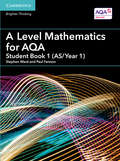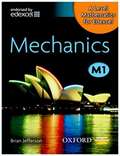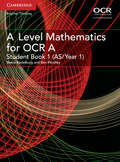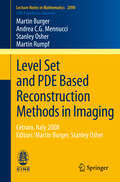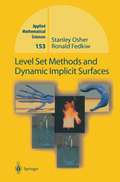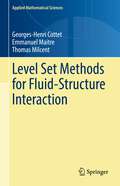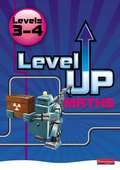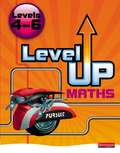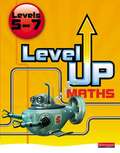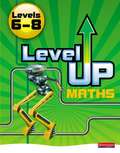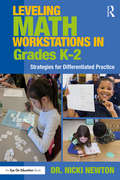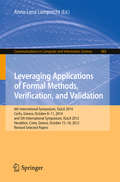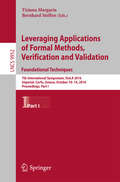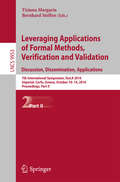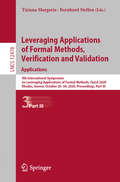- Table View
- List View
A Level Mathematics for AQA Student Book 1 (AS/Year 1) (PDF)
by Stephen Ward Paul Fannon Vesna Kadelburg Ben WoolleyNew 2017 Cambridge A Level Maths and Further Maths resources help students with learning and revision. Written for the AQA AS/A Level Mathematics specifications for first teaching from 2017, this print Student Book covers the content for AS and the first year of A Level. It balances accessible exposition with a wealth of worked examples, exercises and opportunities to test and consolidate learning, providing a clear and structured pathway for progressing through the course. It is underpinned by a strong pedagogical approach, with an emphasis on skills development and the synoptic nature of the course. Includes answers to aid independent study.
A Level Mathematics for Edexcel: Mechanics (PDF)
by Brian JeffersonOxford A Level Mathematics for Edexcel covers the latest 2008 curriculum changes and also takes a completely fresh look at presenting the challenges of A Level. It specifically targets average students, with tactics designed to offer real chance of success to more students, as well as providing more stretch and challenge material.This Mechanics 1 book includes a background knowledge chapter to help bridge the gap between GCSE and A Level study. Note: page 171 is missing from this book.
A Level Mathematics For Edexcel: Statistics S2 (PDF)
by James NicholsonOxford A Level Mathematics for Edexcel covers the latest 2008 curriculum changes and also takes a completely fresh look at presenting the challenges of A Level. It specifically targets average students, with tactics designed to offer real chance of success to more students, as well asproviding more stretch and challenge material.
A Level Mathematics for Edexcel: Core C3/C4
by M. R. HeylingsOxford A Level Mathematics for Edexcel takes a completely fresh look at presenting the challenges of A Level. It specifically targets average students, with tactics designed to offer real chance of success to more students, as well as providing more stretch and challenge material. This Core book includes a background knowledge chapter to help bridge the gap between AS and A2 study, as well as a CD containing a wealth of further practice material and worked solutions
A Level Mathematics for Edexcel: Further Pure FP2
by Mark RowlandOxford A Level Mathematics for Edexcel takes a completely fresh look at presenting the challenges of A Level. It specifically targets average students, with tactics designed to offer real chance of success to more students, as well as providing more stretch and challenge material.
A Level Mathematics for OCR A Student Book 1 (AS/ Year 1) (PDF)
by Vesna Kadelburg Ben Woolley Paul Fannon Stephen WardNew 2017 Cambridge A Level Maths and Further Maths resources help students with learning and revision. Written for the OCR AS/A Level Mathematics specifications for first teaching from 2017, this print Student Book covers the content for AS and the first year of A Level. It balances accessible exposition with a wealth of worked examples, exercises and opportunities to test and consolidate learning, providing a clear and structured pathway for progressing through the course. It is underpinned by a strong pedagogical approach, with an emphasis on skills development and the synoptic nature of the course. Includes answers to aid independent study.
A Level Mathematics For OCR Student Book 1 (as/year 1) (PDF)
by Vesna Kadelburg Ben WoolleyNew 2017 Cambridge A Level Maths and Further Maths resources help students with learning and revision. Written for the OCR AS/A Level Mathematics specifications for first teaching from 2017, this print Student Book covers the content for AS and the first year of A Level. It balances accessible exposition with a wealth of worked examples, exercises and opportunities to test and consolidate learning, providing a clear and structured pathway for progressing through the course. It is underpinned by a strong pedagogical approach, with an emphasis on skills development and the synoptic nature of the course. Includes answers to aid independent study.
A Level Mathematics Year 2 Student Book
by Chris Pearce Helen Ball Michael Kent Kath HipkissPrepare to excel in the new linear Mathematics A-level with this student book suitable for use with all UK exam boards. It covers all the pure, mechanics and statistics content needed for Year 2 of the 2017 A-level Mathematics specifications, and combines comprehensive and supportive explanations with plenty of exam-style practice.
A Level Maths Essentials Core 3 for OCR (PDF)
by Janet CrawshawThis series contains the most focused resources for the 'mainstream' modules of the AS and A-Level courses. Providing thorough exam preparation through detailed worked examples, practise questions and further practise on the CD-ROM, these are the most supportive, OCR revision resources available. Checked by examiners, students can have complete confidence in covering all the topics for Edexcel Maximises students' marks by honing their exam technique with examiner tips, a sample module paper and step-by-step solutions on CD-ROM Includes theory and strategies for answering each type of question with progressive questions and Powerpoint model answers to strengthen understanding and application. A perfect match to each module of OCR
A Level Maths Essentials Core 4 for OCR (PDF)
by Kathryn Scott Janet CrawshawThis series contains the most focused resources for the 'mainstream' modules of the new AS and A-Level courses. Providing thorough exam preparation through detailed worked examples, practise questions and further practise on the CD-ROM, this is the most supportive, OCR revision resource available. Checked by examiners, students can have complete confidence in covering all the topics for Edexcel. Maximises students' marks by honing their exam technique with examiner tips, a sample module paper and step-by-step solutions on CD-ROM. Includes theory and strategies for answering each type of question with progressive questions and Powerpoint model answers to strengthen understanding and application. A perfect match to each module of OCR
Level Set and PDE Based Reconstruction Methods in Imaging: Cetraro, Italy 2008, Editors: Martin Burger, Stanley Osher (Lecture Notes in Mathematics #2090)
by Martin Burger Andrea C.G. Mennucci Stanley Osher Martin RumpfThis book takes readers on a tour through modern methods in image analysis and reconstruction based on level set and PDE techniques, the major focus being on morphological and geometric structures in images. The aspects covered include edge-sharpening image reconstruction and denoising, segmentation and shape analysis in images, and image matching. For each, the lecture notes provide insights into the basic analysis of modern variational and PDE-based techniques, as well as computational aspects and applications.
Level Set Methods and Dynamic Implicit Surfaces (Applied Mathematical Sciences #153)
by Stanley Osher Ronald FedkiwVery hot area with a wide range of applications; Gives complete numerical analysis and recipes, which will enable readers to quickly apply the techniques to real problems; Includes two new techniques pioneered by Osher and Fedkiw; Osher and Fedkiw are internationally well-known researchers in this area
Level Set Methods for Fluid-Structure Interaction (Applied Mathematical Sciences #210)
by Georges-Henri Cottet Emmanuel Maitre Thomas MilcentThis monograph is devoted to Eulerian models for fluid-structure interaction by applying the original point of view of level set methods.In the last 15 years, Eulerian models have become popular tools for studying fluid-structure interaction problems. One major advantage compared to more conventional methods such as ALE methods is that they allow the use of a single grid and a single discretization method for the different media. Level set methods in addition provide a general framework to follow the fluid-solid interfaces, to represent the elastic stresses of solids, and to model the contact forces between solids.This book offers a combination of mathematical modeling, aspects of numerical analysis, elementary codes and numerical illustrations, providing the reader with insights into the applications and performance of these models.Assuming background at the level of a Master’s degree, Level Set Methods for Fluid-Structure Interaction provides researchers in the fields of numerical analysis of PDEs, theoretical and computational mechanics with a basic reference on the topic. Its pedagogical style and organization make it particularly suitable for graduate students and young researchers.
Level Sets and Extrema of Random Processes and Fields
by Jean-Marc Azais Mario WscheborA timely and comprehensive treatment of random field theory with applications across diverse areas of study Level Sets and Extrema of Random Processes and Fields discusses how to understand the properties of the level sets of paths as well as how to compute the probability distribution of its extremal values, which are two general classes of problems that arise in the study of random processes and fields and in related applications. This book provides a unified and accessible approach to these two topics and their relationship to classical theory and Gaussian processes and fields, and the most modern research findings are also discussed. The authors begin with an introduction to the basic concepts of stochastic processes, including a modern review of Gaussian fields and their classical inequalities. Subsequent chapters are devoted to Rice formulas, regularity properties, and recent results on the tails of the distribution of the maximum. Finally, applications of random fields to various areas of mathematics are provided, specifically to systems of random equations and condition numbers of random matrices. Throughout the book, applications are illustrated from various areas of study such as statistics, genomics, and oceanography while other results are relevant to econometrics, engineering, and mathematical physics. The presented material is reinforced by end-of-chapter exercises that range in varying degrees of difficulty. Most fundamental topics are addressed in the book, and an extensive, up-to-date bibliography directs readers to existing literature for further study. Level Sets and Extrema of Random Processes and Fields is an excellent book for courses on probability theory, spatial statistics, Gaussian fields, and probabilistic methods in real computation at the upper-undergraduate and graduate levels. It is also a valuable reference for professionals in mathematics and applied fields such as statistics, engineering, econometrics, mathematical physics, and biology.
Level Up Maths: Levels 3-4 (PDF)
by Ian BooteFun activities appeal to lower attainers. Colourful presentation engages pupils. Write-on format to save you time and resources.
Level Up Maths: Levels 4-6 (PDF)
by Keith PledgerLevelled and sub-levelled questions provide clear differentiation and progression with a bright and innovative design that enhances the pupil experience.
Level Up Maths: Levels 5-7 (PDF)
by Keith PledgerLevelled key points and practice questions provide explicit differentiation. High impact images put maths in an exciting context. Stimulating, fun and exciting activities provide a memorable learning experience. Extended activities give pupils plenty of opportunities for problem solving and peer discussion.
Level Up Maths: Pupil Book (Level 6-8) (PDF)
by Keith Pledger Amanda BearneLevelled key points and practice questions provide explicit differentiation. High impact images put maths in an exciting context. Stimulating, fun and exciting activities provide a memorable learning experience. Extended activities give pupils plenty of opportunities for problem solving and peer discussion. SAT-style questions at the end of every Unit ensure pupils are fully prepared.
Leveling Math Workstations in Grades K–2: Strategies for Differentiated Practice
by Nicki NewtonIn this book from bestselling author Dr. Nicki Newton, you’ll learn how to level math workstations to engage K–2 students in meaningful, purposeful, rigorous practice. We know students don’t learn at the same pace, so how do we take into account where they are and differentiate instruction? Dr. Nicki has the answers, showing how leveled workstations are key in the formative years, how they help students operate in their zone of proximal development and how we can use them to help students progress to higher levels of math achievement. Topics include: Understanding the framework for leveled workstations Making sure workstations are rigorous and not just providing busy work Building your stations in key areas such as counting, numbers, place value, fluency and word problems Keeping students accountable, and knowing where they are in their learning trajectory Each chapter offers specific examples, activities and tools. There is also a clear, step-by-step action plan to help you implement the ideas immediately in your own classroom.
Leveling Math Workstations in Grades K–2: Strategies for Differentiated Practice
by Nicki NewtonIn this book from bestselling author Dr. Nicki Newton, you’ll learn how to level math workstations to engage K–2 students in meaningful, purposeful, rigorous practice. We know students don’t learn at the same pace, so how do we take into account where they are and differentiate instruction? Dr. Nicki has the answers, showing how leveled workstations are key in the formative years, how they help students operate in their zone of proximal development and how we can use them to help students progress to higher levels of math achievement. Topics include: Understanding the framework for leveled workstations Making sure workstations are rigorous and not just providing busy work Building your stations in key areas such as counting, numbers, place value, fluency and word problems Keeping students accountable, and knowing where they are in their learning trajectory Each chapter offers specific examples, activities and tools. There is also a clear, step-by-step action plan to help you implement the ideas immediately in your own classroom.
Leveraged Exchange-Traded Funds: Price Dynamics and Options Valuation (SpringerBriefs in Quantitative Finance)
by Tim Leung Marco SantoliThis book provides an analysis, under both discrete-time and continuous-time frameworks, on the price dynamics of leveraged exchange-traded funds (LETFs), with emphasis on the roles of leverage ratio, realized volatility, investment horizon, and tracking errors. This study provides new insights on the risks associated with LETFs. It also leads to the discussion of new risk management concepts, such as admissible leverage ratios and admissible risk horizon, as well as the mathematical and empirical analyses of several trading strategies, including static portfolios, pairs trading, and stop-loss strategies involving ETFs and LETFs. The final part of the book addresses the pricing of options written on LETFs. Since different LETFs are designed to track the same reference index, these funds and their associated options share very similar sources of randomness. The authors provide a no-arbitrage pricing approach that consistently value options on LETFs with different leverage ratios with stochastic volatility and jumps in the reference index. Their results are useful for market making of these options, and for identifying price discrepancies across the LETF options markets. As the market of leveraged exchange-traded products become a sizeable connected part of the financial market, it is crucial to better understand its feedback effect and broader market impact. This is important not only for individual and institutional investors, but also for regulators.
Leveraging Applications of Formal Methods, Verification, and Validation: 6th International Symposium, ISoLA 2014, Corfu, Greece, October 8-11, 2014, and 5th International Symposium, ISoLA 2012, Heraklion, Crete, Greece, October 15-18, 2012, Revised Selected Papers (Communications in Computer and Information Science #683)
by Anna-Lena LamprechtThis book constitutes the refereed proceedings of the 6th International Symposium on Leveraging Applications of Formal Methods, Verification, and Validation, ISoLA 2014, held in Corfu, Greece, in October 2014, and the 5th International Symposium, ISoLA 2012, held in Heraklion, Crete, Greece, in October 2012. The 9 revised full papers presented were carefully reviewed and selected from 22 submissions. This volume combines the post-conference proceedings of the 2014 Doctoral Symposium and the 2014 Tutorial "Automata Learning in Practice" with the post-conference publication of selected contributions from the Tracks "Process-Oriented Geoinformation Systems and Applications" and "Processes and Data Integration in the Networked Healthcare" of ISoLA 2012.
Leveraging Applications of Formal Methods, Verification and Validation: 7th International Symposium, ISoLA 2016, Imperial, Corfu, Greece, October 10–14, 2016, Proceedings, Part I (Lecture Notes in Computer Science #9952)
by Tiziana Margaria Bernhard SteffenThe two-volume set LNCS 9952 and LNCS 9953 constitutes the refereed proceedings of the 7th International Symposium on Leveraging Applications of Formal Methods, Verification and Validation, ISoLA 2016, held in Imperial, Corfu, Greece, in October 2016. The papers presented in this volume were carefully reviewed and selected for inclusion in the proceedings. Featuring a track introduction to each section, the papers are organized in topical sections named: statistical model checking; evaluation and reproducibility of program analysis and verification; ModSyn-PP: modular synthesis of programs and processes; semantic heterogeneity in the formal development of complex systems; static and runtime verification: competitors or friends?; rigorous engineering of collective adaptive systems; correctness-by-construction and post-hoc verification: friends or foes?; privacy and security issues in information systems; towards a unified view of modeling and programming; formal methods and safety certification: challenges in the railways domain; RVE: runtime verification and enforcement, the (industrial) application perspective; variability modeling for scalable software evolution; detecting and understanding software doping; learning systems: machine-learning in software products and learning-based analysis of software systems; testing the internet of things; doctoral symposium; industrial track; RERS challenge; and STRESS.
Leveraging Applications of Formal Methods, Verification and Validation: 7th International Symposium, ISoLA 2016, Imperial, Corfu, Greece, October 10-14, 2016, Proceedings, Part II (Lecture Notes in Computer Science #9953)
by Tiziana Margaria Bernhard SteffenThe two-volume set LNCS 9952 and LNCS 9953 constitutes the refereed proceedings of the 7th International Symposium on Leveraging Applications of Formal Methods, Verification and Validation, ISoLA 2016, held in Imperial, Corfu, Greece, in October 2016. The papers presented in this volume were carefully reviewed and selected for inclusion in the proceedings. Featuring a track introduction to each section, the papers are organized in topical sections named: statistical model checking; evaluation and reproducibility of program analysis and verification; ModSyn-PP: modular synthesis of programs and processes; semantic heterogeneity in the formal development of complex systems; static and runtime verification: competitors or friends?; rigorous engineering of collective adaptive systems; correctness-by-construction and post-hoc verification: friends or foes?; privacy and security issues in information systems; towards a unified view of modeling and programming; formal methods and safety certification: challenges in the railways domain; RVE: runtime verification and enforcement, the (industrial) application perspective; variability modeling for scalable software evolution; detecting and understanding software doping; learning systems: machine-learning in software products and learning-based analysis of software systems; testing the internet of things; doctoral symposium; industrial track; RERS challenge; and STRESS.
Leveraging Applications of Formal Methods, Verification and Validation: 9th International Symposium on Leveraging Applications of Formal Methods, ISoLA 2020, Rhodes, Greece, October 20–30, 2020, Proceedings, Part III (Lecture Notes in Computer Science #12478)
by Tiziana Margaria Bernhard SteffenThe three-volume set LNCS 12476 - 12478 constitutes the refereed proceedings of the 9th International Symposium on Leveraging Applications of Formal Methods, ISoLA 2020, which was planned to take place during October 20–30, 2020, on Rhodes, Greece. The event itself was postponed to 2021 due to the COVID-19 pandemic. The papers presented were carefully reviewed and selected for inclusion in the proceedings. Each volume focusses on an individual topic with topical section headings within the volume:Part I, Verification Principles: Modularity and (De-)Composition in Verification; X-by-Construction: Correctness meets Probability; 30 Years of Statistical Model Checking; Verification and Validation of Concurrent and Distributed Systems. Part II, Engineering Principles: Automating Software Re-Engineering; Rigorous Engineering of Collective Adaptive Systems. Part III, Applications: Reliable Smart Contracts: State-of-the-art, Applications, Challenges and Future Directions; Automated Verification of Embedded Control Software; Formal methods for DIStributed COmputing in future RAILway systems.
